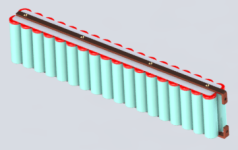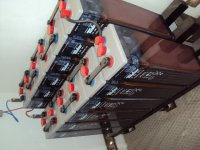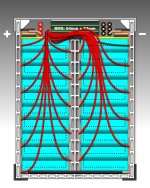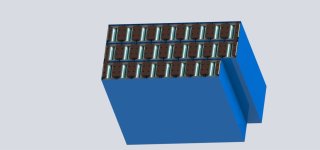Hi,
I usually build 10s, 13s and 20s battery pack for ebikes, but I've been asked to build a 26s36p battery pack for a home made electric motorcycle.
Instead of building one block battery (47kg), I'd rather make it modular, with 26 "bricks" of 36 cells in parallel (1.8Kg each). This way, the battery will be a lot easier to move around and assemble in the motorbike.
Each brick will have + pos and - neg terminals, and then connect all the bricks in series with wires. The same way they do with the 2V batteries for solar panels. (Photo attached to show the serial connections).
The battery will have a demand of 150A continuous current and unto 600A peak.
I'm used to calculate nickel strip width and thickness to deal with the current demand, but for this brick design and the current demand I want to spot weld all the cells to a copper? strip (27-30mm wide) and a copper? busbar as a spine going from the bottom to the top to carry all the current.
I wonder if you could shed some light with tables, formulas or links to help me with the calculations of best section, material,... for the busbar and strip.
What's the best way to ensure the right contact between the busbar and stip? Bolted would be enough?
Thanks
I usually build 10s, 13s and 20s battery pack for ebikes, but I've been asked to build a 26s36p battery pack for a home made electric motorcycle.
Instead of building one block battery (47kg), I'd rather make it modular, with 26 "bricks" of 36 cells in parallel (1.8Kg each). This way, the battery will be a lot easier to move around and assemble in the motorbike.
Each brick will have + pos and - neg terminals, and then connect all the bricks in series with wires. The same way they do with the 2V batteries for solar panels. (Photo attached to show the serial connections).
The battery will have a demand of 150A continuous current and unto 600A peak.
I'm used to calculate nickel strip width and thickness to deal with the current demand, but for this brick design and the current demand I want to spot weld all the cells to a copper? strip (27-30mm wide) and a copper? busbar as a spine going from the bottom to the top to carry all the current.
I wonder if you could shed some light with tables, formulas or links to help me with the calculations of best section, material,... for the busbar and strip.
What's the best way to ensure the right contact between the busbar and stip? Bolted would be enough?
Thanks







